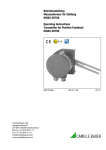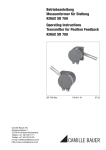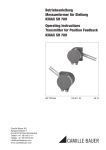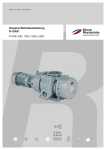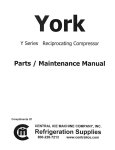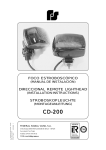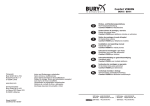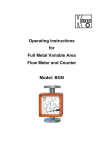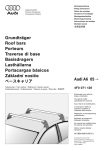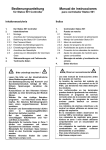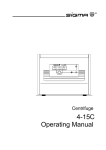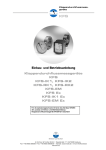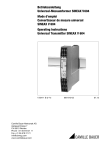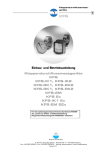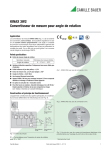Download Betriebsanleitung Messumformer für Drehwinkel KINAX WT 710
Transcript
Betriebsanleitung Messumformer für Drehwinkel KINAX WT 710 Mode d’emploi Convertisseur de mesure pour angle de rotation KINAX WT 710 Operating Instructions Transmitter for angular position KINAX WT 710 WT 710 Bdfe Camille Bauer AG Aargauerstrasse 7 CH-5610 Wohlen/Switzerland Telefon +41 56 618 21 11 Telefax +41 56 618 35 35 [email protected] www.camillebauer.com 139 429-04 06.10 Betriebsanleitung Messumformer für Drehwinkel KINAX WT 710 .............................................................................. 3 Mode d’emploi Convertisseur de mesure pour angle de rotation KINAX WT 710 .........................................10 Operating Instructions Transmitter for angular position KINAX WT 710 ..............................................................................17 Sicherheitshinweise, die unbedingt beachtet werden müssen, sind in dieser Betriebsanleitung mit folgenden Symbolen markiert: Les conseils de sécurité qui doivent impérativement être observés sont marqués des symboles ci-contre dans le présent mode d’emploi: Safety precautions to be strictly observed are marked with following symbols in the Operating Instructions: Der Anbau eines Zusatzgetriebes an den WT 710 muss im Herstellerwerk erfolgen! L’adjonction d’un engrenage additionnel en WT 710 doit être faite en usine! The mounting of an additional gear on the WT 710 must be made at the factory Geräte dürfen nur fachgerecht entsorgt werden! Les appareils ne peuvent être éliminés que de façon appropriée! The instruments must only be disposed of in the correct way! 2 Betriebsanleitung Messumformer für Drehwinkel KINAX WT 710 Inhaltsverzeichnis 1. Erst lesen, dann… ....................................................... 3 2. Kurzbeschreibung ........................................................ 3 3. Lieferumfang ................................................................ 3 4. Aufschlüsselung der Varianten .................................... 4 5. Technische Daten ........................................................ 4 6. Montage....................................................................... 5 3. Lieferumfang Messumformer (Bild 1) 3 Spannklammern (Bild 4) 1 Schutzkappe 1 Betriebsanleitung (Bild 5), dreisprachig: Deutsch, Französisch, Englisch 1 Ex-Bescheinigung (Bild 5), nur bei Geräten in Ex-Ausführung 7. Elektrische Anschlüsse ................................................ 6 8. Anfangs- und Endwert des Messbereiches einstellen ...................................... 7 9. Umstellung von 2-Drahtanschluss in 3- bzw. 4-Drahtanschluss oder umgekehrt.............. 8 10. Drehrichtung umkehren bei Geräten mit Messbereichen grösser 150 ° .......... 8 11. Mass-Skizzen .............................................................. 8 12. Konformitätserklärung ............................................... 24 1. Erst lesen, dann … Der einwandfreie und gefahrlose Betrieb setzt voraus, dass die Betriebsanleitung gelesen und die in den Abschnitten Bild 1 Messumformer zum Anbau an Messgeräte mit drehbarer Zeigerwelle (Bild 2) 1 Zwischenflansch 1 Dichtungsring 1 Mitnehmergabel für ∅ 1,5 mm am Messgerät 1 Kupplungshebel für ∅ 2 mm am Messumformer 3 Spannklammern (Bild 4) 3 Zylinderschrauben M4 ×8 1 Schutzkappe 1 Betriebsanleitung (Bild 5), dreisprachig: Deutsch, Französisch, Englisch 1 Ex-Bescheinigung (Bild 5), nur bei Geräten in Ex-Ausführung 6. Montage 7. Elektrische Anschlüsse 8. Anfangs- und Endwert des Messbereiches einstellen 10. Drehrichtung umkehren bei Geräten mit Messbereichen grösser 150 enthaltenen Sicherheitshinweise beachtet werden. Der Umgang mit diesem Gerät sollte nur durch entsprechend geschultes Personal erfolgen, das das Gerät kennt und berechtigt ist, Arbeiten in regeltechnischen Anlagen auszuführen. Das Gerät darf nur zum Anschliessen der elektrischen Leitungen (Abschnitt 7) und zum Einstellen wie in Abschnitt 8 bis 10 beschrieben, geöffnet werden. Bild 2 Messumformer mit Zusatzgetriebe (Bild 3) 3 Spannklammern (Bild 4) 1 Montagefuss 2 Sechskantschrauben M5 ×10 2 Federscheiben 1 Betriebsanleitung (Bild 5), dreisprachig: Deutsch, Französisch, Englisch 1 Ex-Bescheinigung (Bild 5), nur bei Geräten in Ex-Ausführung Bei weitergehenden Eingriffen in das Gerät erlischt der Garantieanspruch. Bild 3 Betriebsanleitung Messumformer für Drehwinkel KINAX WT 710 Mode d’emploi convertisseur de mesure pour angle de rotation KINAX WT 710 Operating manual Transmitter for angular position KINAX WT 710 2. Kurzbeschreibung Der Messumformer KINAX WT 710 erfasst kontaktlos die Winkelstellung einer Welle und formt sie in einen eingeprägten, dem Messwert proportionalen Gleichstrom um. Ausführungen in Zündschutzart «Eigensicherheit» mit eigensicherem Messausgang ergänzen die Baureihe des Messumformers. WT 710 B d-f-e 139 429-2 07.06 Camille Bauer AG Aargauerstrasse 7 CH-5610 Wohlen/Switzerland Telefon +41 57 21 21 11 Telefax +41 57 22 74 32 Telex 827 901 cbm ch Bild 4 Bild 5 3 4. Aufschlüsselung der Varianten 5. Technische Daten Erklärung der Bestell-Ziffern 1. bis 5. Messeingang Messbereiche: BestellCode Beschreibung 1. Ausführung des Messumformers 1 Ex ia IIC T6, Messausgang eigensicher 2 ATEX Sonstige Ausführungen 2. 3. 9 Drehrichtung Kalibriert für Drehrichtung Uhrzeigersinn 1 Kalibriert für Drehrichtung Gegenuhrzeigersinn 2 Für V-Kennlinie 3 Kalibriert für Drehrichtung beidseitig und markiert 4 0 … 10 ° 1 0 … 30 ° 2 0 … 60 ° 3 0 … 90 ° 4 0 … 180 ° 5 6 ° Nichtnorm 0 … ≥ 5 bis 0 … < 270 V-Kennlinie [± ° °] nach Auftrag Messausgang Ausgangsgrösse IA: Eingeprägter Gleichstrom, proportional zum Drehwinkel Normbereiche: 0…1 mA, 3- oder 4-Drahtanschluss 0…5 mA, 3- oder 4-Drahtanschluss 0…10 mA, 3- oder 4-Drahtanschluss 4…20 mA, 2-Drahtanschluss oder 0…20 mA, 3- oder 4-Drahtanschluss durch Potentiometer einstellbar 4…20 mA, 3- oder 4-Drahtanschluss 0…20 mA, 4-Drahtanschluss Nicht-Normbereiche: 0…> 1,00 bis 0…< 20 mA 3- oder 4-Drahtanschluss 9 A Aussenwiderstand (Bürde): Ausgangssignal (Messausgang) 0 … 1 mA / 3- oder 4-Drahtanschluss 5. 0…≥ 10 ° bis 0…48 Umdr. (mit Zusatzgetriebe) Messbereich (Messeingang) 0 … 270 4. Vorzugsbereiche 0…10, 0…30, 0…60, 0…90, 0…180 oder 0…270 ° 710- Standard, Messausgang nicht eigensicher 0…≥ 5 bis 0… ≤ 270 ° (ohne Getriebe) Rext max. [kΩ] = 12 V IA [mA] (bei Geräten mit DC/AC-Hilfsenergie durch Allstrom-Netzteil, mit Galvanischer Trennung) A 0 … 5 mA / 3- oder 4-Drahtanschluss B 0 … 10 mA / 3- oder 4-Drahtanschluss C 4 … 20 mA / 2-Drahtanschluss oder 0 … 20 mA / 3- oder 4-Drahtanschluss D Rext max. [kΩ] = 4 … 20 mA / 3- oder 4-Drahtanschluss E (bei Geräten mit DC-Hilfsenergie, ohne Galvanische Trennung) 0 … 20 mA / 4-Drahtanschluss F IA = Ausgangssignal-Endwert Nichtnorm / 3- oder 4-Drahtanschluss 0 … > 1,00 bis 0 … < 20 mA Z H [V] –12 V IA [mA] Genauigkeitsangaben Hilfsenergie 24 … 60 V DC/AC, mit galvanischer Trennung 1 85 … 230 V DC/AC, mit galvanischer Trennung 2 12 … 33 V DC, ohne galvanische Trennung A 12 … 30 V DC (Ex), ohne galvanische Trennung B Bezugswert: Messbereich Grundgenauigkeit: Fehlergrenze ≤ 0,5% für Bereiche 0…≤ 150 ° Fehlergrenze ≤ 1,5% für Bereiche von 0…> 150 bis 0…270 ° Hilfsenergie H Gleich- und Wechselspannung: Nennspannungen und ToleranzAngaben siehe «Tabelle 1» Tabelle 1: Nennspannungen UN Toleranz-Angaben 24 … 60 V DC/AC DC – 15 … + 33% AC ± 15% 85 … 230 V DC/AC Anmerkung: Die noch weiter festgelegten Bestell-Ziffern befassen sich mit Besonderheiten, u.a. mit dem Zusatzgetriebe zur Erweiterung der Messbereiche. 4 (möglich nur bei der Standard-Ausführung, Nicht Ex, mit Galvanischer Trennung, mit Allstrom-Netzteil (DC und 45…400 Hz) Nur Gleichspannung1: 12…33 V (möglich bei der Standard-Ausführung, Nicht Ex, ohne Galvanische Trennung) Umgebungsbedingungen Klimatische Beanspruchung: 12…30 V (erforderlich bei der Ex-Ausführung, Zündschutzart Eigensicherheit Ex ia IIC T6, ohne Galvanische Trennung) Ausführung mit erhöhter Klimafestigkeit Temperatur – 40 bis + 70 °C Rel. Feuchte im Jahresmittel ≤ 95% 10% p.p. Max. Stromaufnahme: Ca. 5 mA + IA Ex-Ausführung Temperatur – 40 bis + 60 °C bei T6 bzw. – 40 bis + 75 °C bei T5 Mechanische Belastbarkeit Vibrationsbeständigkeit (ohne Zusatzgetriebe): 5 g je 2 h in 3 Richtungen f ≤ 200 Hz 3 ×50 g je 10 Stösse in 3 Richtungen Zulässige statische Belastung der Welle: 6. Montage radial max. 16 N 83 N axial max. 25 N 130 N Tabelle 2: Bei Rüttelbetrieb wird zur Erhöhung der Lebensdauer der Lager weitgehende Entlastung der Welle empfohlen 3,2 Beliebig … unmittelbarer Befestigung Werkstoff Feldgehäuse: Alu-Guss Oberfläche eloxiert Deckel aus Kunststoff Stopfbuchsen: Metall Vorschriften 500 Veff, 50 Hz, 1 Min. alle elektrischen Anschlüsse gegen Gehäuse (bei DC-Hilfsenergie, ohne Galvanische Trennung) Stossspannungsfestigkeit: Zul. Gleichtaktspannung: 1 kV, 1,2/50 μs, 0,5 Ws IEC 255-4, Kl. II Ø90 IP 43 nach EN 60 529 ohne Getriebe IP 64 mit Getriebe oder anderem ebenbürtigem Anbau ° M4 12 0 2,2 kVeff, 50 Hz, 1 Min. zwischen… … Hilfsenergie und Gehäuse … Hilfsenergie und Messausgang (bei DC/AC-Hilfsenergie, mit Galvanischer Trennung) ±0,2 Nach EN 60 079-11: 2007 Prüfspannung: Ø75-H7 Eigensicher: Gehäuseschutzart: M3 Die Normen EN 50 081-2 und EN 50 082-2 werden eingehalten … Befestigung mit Spannklammern Elektromagnetische Verträglichkeit: 5 90 Gebrauchslage: Bohr-Ausschnitts-Pläne für Anbauteil (am Messobjekt) bei … MessumformerAusführungen 0° 6 mm bzw. 1/4ʺ 12 2 mm 60 ±0,2 Richtung Die Montagearten – genaugenommen – die zugehörigen BohrAusschnitts-Pläne und ihre Zuordnung zu den MessumformerAusführungen sind Inhalt der Tabelle 2. 15 +0,018 0 Antriebswellen ∅ 75-H7 Schock: Transport- und Lagerungs-Temperatur: – 40 bis 80 °C ±0,2 Max. Restwelligkeit: Standard-Ausführung Temperatur – 25 bis + 70 °C Rel. Feuchte im Jahresmittel ≤ 90% oder Fortsetzung Tabelle 2 siehe nächste Seite! 1 100 V, 50 Hz Gegen Falschpolung geschützt. Der niedrigste Spannungswert darf 12 V nicht unterschreiten. 5 Fortsetzung der Tabelle 2: Beim Festziehen und Ausrichten ist darauf zu achten, dass die Lage des Messumformer-Nullpunktes und die Nullstellung des Messobjektes übereinstimmen. Bohr-Ausschnitts-Pläne für Anbauteil (am Messobjekt) bei … 30° Um ein eventuell notwendiges Verschieben des elektrischen Nullpunktes auf die Nullstellung des Messobjektes zu ermöglichen, wird empfohlen, auch die 3 Durchgangslöcher (3,2 mm Ø) für die «unmittelbare» Befestigung (siehe oberer Bohr-Ausschnitts-Plan in «Tabelle 2») als Langlöcher auszuführen. Der elektrische Nullpunkt des Gerätes ist auf der Stirnseite der Welle und aussen auf dem Gehäuse markiert, siehe Abbildungen: – links für Drehwinkel-Messumformer mit Bereichen 0 bis … °, – rechts für Winkeltransmitter mit V-Kennlinien-Bereichen. Ø6,8 80 ±0,2 95 80 52 44-H8 7. Elektrische Anschlüsse 113 Zum Anschliessen der elektrischen Leitungen ist der Messumformer mit Schraubklemmen und 2 Stopfbuchsen ausgerüstet. 61 Unbedingt sicher stellen, dass die Leitungen beim Anschliessen spannungsfrei sind! 25 Möglicherweise drohende Gefahr, 230 V Netzspannung als Hilfsenergie 0° M4 12 … Anbau an Messgeräte mit drehbarer Zeigerwelle … Befestigung mit Montagefuss MessumformerAusführungen Ferner ist zu beachten, … 53 ±0,05 Die «unmittelbare» Befestigung verlangt 3 Schrauben M3, wohingegen die «mit Fuss» 2 Schrauben M6 mit Muttern erfordern. Die Schrauben gehören nicht zum Lieferumfang, da ihre Längen durch die von Fall zu Fall schwankende Dicke des Anbauteils am Messobjekt bestimmt werden. Anbauteil (am Messobjekt) mit Ausschnitt und/oder Durchgangslöchern nach dem zutreffenden Bohr-AusschnittsPlan «Tabelle 2» versehen. Danach den Messumformer montieren. Bei der Festlegung des Montageortes (Messortes) ist zu berücksichtigen, dass die Angaben unter «Umgebungsbedingungen», Abschnitt «5. Technische Daten», eingehalten werden. Bei Ex-Geräten ist beim Errichten und Warten darauf zu achten, dass keine elektrostatische Aufladung entsteht. Der Messumformer darf nur zum Erfassen eines Drehwinkels und nicht zur permanenten Drehzahlerfassung benutzt werden. … dass die Daten, die zur Lösung der Messaufgabe erforderlich sind, mit denen auf dem Typenschild (Bild 6) des KINAX WT 710 übereinstimmen (Messeingang, Messausgang, Hilfsenergie)! … dass der Gesamtwiderstand in der Messausgangsleitung (in Serie geschaltete Empfangsgeräte plus Leitung) den maximalen Aussenwiderstand Rext. max. nicht überschreitet! Rext. max. siehe «Messausgang», Abschnitt «5. Technische Daten»! … dass bei der Verlegung der Messausgangsleitung verdrillte Kabel verwendet werden und diese möglichst getrennt von Starkstromleitungen zu verlegen sind! Im übrigen landesübliche Vorschriften (z.B. für Deutschland VDE 0100 «Bedingungen über das Errichten von Starkstromanlagen mit Nennspannungen unter 1000 Volt») bei der Installation und Auswahl des Materials der elektrischen Leitungen befolgen! Bei Geräten in der Zündschutzart «Eigensicherheit» mit eigensicherem Messausgang sind zusätzlich die Angaben der Baumusterprüfbescheinigung, die EN 60 079-14, sowie die nationalen Vorschriften für die Errichtung von elektrischen Anlagen in explosionsgefährdeten Bereichen zu berücksichtigen! 1.5 ! 0.5 Typ WT710-216A B1AC EF// P 12 -30 V 0 -270° 0 – 1 mA Manufactured: 1999 No. 710/710710/001/001 camille bauer AG, CH-5610 Wohlen, Switzerland Bild 6. Beispiel eines Typenschildes. 6 7.1 Leitungen anschliessen Im Gehäuse (1) befinden sich 4 Schraubklemmen (2.1) und 1 Erdungsanschluss (2.2). Die Schraubklemmen eignen sich für max. 1,5 mm2 Drahtquerschnitte und sind nach Abnehmen des Deckels zugänglich. 21 43 + – – + (1) ZERO SPAN ZERO (2.2) S1 SPAN + S1 Rext – (2.1) (2.2) + – ~ ~ A (2) H 4-Drahtanschluss (diverse mA-Signale) A = Messausgang H = DC/AC-Hilfsenergie Rext = Aussenwiderstand Bild 7. Gehäuse (1), Deckel abgenommen, mit Klemmen (2.1) sowie Erdungsanschluss (2.2) und Stopfbuchsen (2). Links: Gerät ohne Galvanische Trennung und mit DC-Hilfsenergie. Bild 9. Anschlussplan für 4-Drahtanschluss, mit Galvanischer Trennung, DC/AC-Hilfsenergie. Rechts: Gerät mit Galvanischer Trennung und mit DC/AC-Hilfsenergie (Schaltnetzteil). 8. Anfangs- und Endwert des Messbereiches einstellen Kunststoff-Deckel abnehmen. Stopfbuchs-Verschraubungen lösen und zusammen mit den Quetschringen und Dichtungen aus den StopfbuchsÖffnungen herausnehmen. Diese Verschraubungsteile auf die Leitungen auffädeln, und die Leitungsenden durch die Stopfbuchs-Öffnungen ins Gehäuse stecken und durchziehen. Sodann die Leitungsenden auf passende Länge abisolieren und nach dem jeweils zutreffenden Anschlussplan (Bild 8 oder 9) an den Klemmen (2.1) und Erdungsanschluss (2.2) anschliessen. Danach die Verschraubungsteile in den Stopfbuchs-Öffnungen festziehen, und den Deckel wieder anbringen. Die «grobe» Einstellung des Messbereich-Anfangswertes, die darin besteht, die Nullstellung des Messobjektes auf den äusserlich markierten Nullpunkt des Messumformers auszurichten, wurde bereits unter «6. Montage» beschrieben. In diesem Abschnitt wird dagegen die genaue Einstellung, der Feinabgleich, sowohl des Anfangswertes (Nullpunkt/ZERO) als auch des Endwertes (Spanne/SPAN) behandelt. Messumformer in Betrieb nehmen. Dazu einfach die Hilfsenergie einschalten. Deckel vom Gehäuse abnehmen. Achtung! Die Schraubklemmen (2.1) Bild 7 führen Strom. Möglicherweise drohende Gefahr, 230 V Netzspannung als Hilfsenergie + – Nun das Messobjekt in Nullstellung bringen, d.h. in die Position, in der der KINAX WT 710 den Ausgangsstrom 0 mA (bei einem 3- oder 4-Drahtanschluss) bzw. 4 mA (bei dem 2-Drahtanschluss) ausgeben soll. 21 – + 21 + – 43 43 43 21 + + – Brücke Weicht der Ausgangsstrom mehr als 2% von seinem Anfangswert ab, dann zunächst die «grobe» Nullpunkteinstellung, siehe Abschnitt «6. Montage», wiederholen. – Rext Rext Rext + – – + – A und H Danach Potentiometer «ZERO» (Bild 10 bzw. Bild 11) mit einem Uhrmacher-Schraubenzieher (Ø 2,3 mm) so drehen, dass genau der gewünschte Ausgangsstrom fliesst. + + – A + H + A – H 2-Drahtanschluss 3-Drahtanschluss 4-Drahtanschluss (4…20 mA) (diverse (diverse mA-Signale) mA-Signale) A H Rext = Messausgang … … als 2-Drahtanschluss (4…20 mA, Signal im Mess-Speise-Kreis) … als 3- oder 4-Drahtanschluss (diverse mA-Signale) = DC-Hilfsenergie H = 12…33 V bzw. H = 12…30 V bei Ex-Ausführung = Aussenwiderstand Bild 8. Anschlusspläne für 2-, 3- oder 4-Drahtanschluss, ohne Galvanische Trennung, DC-Hilfsenergie. (1) ZERO SPAN S1 Bild 10. Gehäuse (1) mit den Einstell-Elementen «ZERO», «SPAN» und «S1». 7 Bei einem allfälligen Wechsel im Anschliessen des Gerätes (siehe Anschlusspläne in Bild 8) müssen jedoch Anfangs- und Endwert des Messbereiches neu eingestellt werden. 10. Drehrichtung umkehren bei Geräten mit Messbereichen grösser 150 ° (1) ZERO SPAN Winkeltransmitter mit Messbereichen > 150 ° haben für die Drehrichtungsumkehr einen Schalter, der mit S1 bezeichnet ist (Bild 10 und Bild 11). S1 Deckel vom Gehäuse abnehmen. Achtung! die Schraubklemmen (2.1) Bild 7 führen Strom. Bild 11. Gehäuse (1), Ausführung mit Schaltnetzteil, mit den Einstell-Elementen «ZERO», «SPAN» und «S1». Möglicherweise drohende Gefahr, 230 V Netzspannung als Hilfsenergie Sodann Messobjekt in Endlage drehen, d.h. in die Stellung, in der der KINAX WT 710 den ihm zugedachten AusgangsstromEndwert, siehe Typenschild, haben soll. Sodann den Schalter mit dem Uhrmacher-Schraubenzieher (Ø 2,3 mm) mit einer Vierteldrehung umschalten und Anfangsund Endwert des Messbereiches neu einstellen. Potentiometer «SPAN» mit dem erwähnten Schraubenzieher derart drehen, dass genau der gewünschte AusgangsstromEndwert abgegeben wird. Danach wieder eine Kontrolle des Nullpunktes vornehmen und allenfalls mit dem ZERO-Potentiometer korrigieren. Danach nochmal den Endwert prüfen. Beide Justiervorgänge solange wiederholen bis Nullpunkt und Endwert genau stimmen. S1 Achtung! Bei Geräten mit Messbereichen kleiner 150 ° ist der Schalter S1 nicht vorhanden. Bei Einführung eines Uhrmacher-Schraubenziehers wird die Leiterplatte beschädigt. 9. Umstellung von 2-Drahtanschluss in 3- bzw. 4-Drahtanschluss oder umgekehrt Messumformer mit dem Bestell-Code 710 – ...D (siehe Abschnitt «4. Aufschlüsselung der Varianten») sind sowohl für den 2-Drahtanschluss mit dem Ausgangsstrom 4…20 mA als auch für den 3- bzw. 4-Drahtanschluss mit dem Ausgangsstrom 0…20 mA geeignet. 11. Mass-Skizzen 80 61 101 Ø2-h5 KINAX WT 710 Grundgerät Ø75-f8 6 10,7 3 47 25 63,1 80 61 101 Ø6-h5 KINAX WT 710 Grundgerät mit Zusatzgetriebe Ø75-f8 15 21,5 3 94 110,1 8 25 5 3,2 12 0° 60 ±0,2 15 +0,018 0 M3 Bohr-Ausschnittsplan für Befestigung mit Zylinderschrauben ±0,2 Befestigung mit Montagefuss 75-H7 50 30° Ø90 Ø75-H7 90 ±0,2 Bohr-Ausschnittsplan für Befestigung mit Spannklammern 12 0° M4 Ø6,8 80 ±0,2 50 95 37 (Falls bei dieser Montageart die Stopfbuchse im Weg sein sollte, ist der KINAX WT 710 um 120° zu drehen, vorher sind die drei Rundmuttern am Getriebe zu lösen). 61 113 Grundgerät zum Anbau an Messgeräte mit drehbarer Zeigerwelle Ø80 52 44-H8 67 25 83,1 Das Messgerät muss mit rückseitig verlängerter Zeigerwelle (Durchmesser 1,5 mm, Länge 6…7 mm) ausgeführt werden. 12 0° M4 Bohr-Ausschnittsplan für Messgeräte-Gehäuse 53 ±0,05 Anbausatz für Manometer 9 Mode d’emploi Convertisseur de mesure pour angle de rotation KINAX WT 710 3. Etendue de la livraison Sommaire 1. A lire en premier, ensuite… ........................................ 10 2. Description brève....................................................... 10 3. Etendue de la livraison............................................... 10 4. Codage des variantes ................................................ 11 5. Caractéristiques techniques ...................................... 11 Convertisseur de mesure (Fig. 1) 3 brides (Fig. 4) 1 capuchon protecteur 1 mode d’emploi (Fig. 5) en trois langues: allemand, français, anglais 1 attestation Ex (Fig. 5), seulement pour Ex-versions 6. Montage .................................................................... 12 7. Raccordements électriques ....................................... 13 8. Ajustage des valeurs de début et de fin de l’étendue de mesure ............................................. 14 9. Passage du raccordement à 2 fils à 3 ou 4 fils ou vice versa .......................................... 15 10. Inversion du sens de rotation pour des appareils avec étendues de mesure > 150 ° ......... 15 11. Croquis d’encombrements ........................................ 15 12. Certificat de conformité ............................................. 24 1. A lire en premier, ensuite … Pour un fonctionnement sûr et sans danger, il est essentiel de lire le présent mode d’emploi et de respecter les recommandations de sécurité mentionnées dans les rubriques Ffig. 1 Convertisseur de mesure pour montage à l’arrière d’appareils de mesure (Fig. 2) 1 flasque annulaire 1 joint torique 1 fourchette d’entraînement pour ∅ 1,5 mm à fixer à l’appareil de mesure 1 levier d’accouplement pour ∅ 2 mm à fixer au convertisseur de mesure 3 brides (Fig. 4) 3 vis cylindrique M4 ×8 1 capuchon protecteur 1 mode d’emploi (Fig. 5) en trois langues: allemand, français, anglais 1 attestation Ex (Fig. 5), seulement pour Ex-versions 6. Montage 7. Raccordements électriques 8. Ajustage des valeurs de début et de fin de l’étendue de mesure 10. Inversion du sens de rotation pour des appareils avec étendues de mesure > 150 Ces appareils devraient uniquement être manipulés par des personnes qui les connaissent et qui sont autorisées à travailler sur des installations techniques du réglage. L’appareil ne doit être ouvert que pour le raccordement des lignes électriques (chapitre 7) et pour l’ajustage, comme décrit au chapitre 8 à 10. Fig. 2 Convertisseur de mesure avec engrenage additionnel (Fig. 3) 3 brides (Fig. 4) 1 pied de montage 2 vis hexagonale M5 ×10 2 rondelles ressorts 1 mode d’emploi (Fig. 5)en trois langues: allemand, français, anglais 1 attestation Ex (Fig. 5), seulement pour Ex-versions En cas d’intervention plus poussée, la garantie d’usine s’éteint. Fig. 3 Betriebsanleitung Messumformer für Drehwinkel KINAX WT 710 Mode d’emploi convertisseur de mesure pour angle de rotation KINAX WT 710 Operating manual Transmitter for angular position KINAX WT 710 2. Description brève Le convertisseur de mesure KINAX WT 710 est destiné à la conversion, sans contact, de la position angulaire d’un axe en un courant continu proportionnel à cet angle. La gamme livrable du convertisseur est complétée par une version en mode de protection à «sécurité intrinsèque» avec sortie de mesure à sécurité intrinsèque.. 10 WT 710 B d-f-e Camille Bauer AG Aargauerstrasse 7 CH-5610 Wohlen/Switzerland Telefon +41 57 21 21 11 Telefax +41 57 22 74 32 Telex 827 901 cbm ch Fig. 4 Fig. 5 139 429-2 07.06 4. Codage des variantes 5. Caractéristiques techniques Explication des chiffres de commande 1. à 5. Entrée de mesure Etendues de mesure: Code de cde. Description 1. 2. 3. 710- Standard, sortie de mesure pas à sécurité intrinsèque 1 Etendues préférentielles 0…10, 0…30, 0…60, 0…90, 0…180 ou 0…270 ° Ex ia IIC T6, ATEX Sortie de mesure à sécurité intrinsèque 2 0…≥ 10 ° à 0…48 tours (avec engrenage) Autres exécutions 9 Sens de rotation Etalonné pour sens horaire 1 Etalonné pour sens antihoraire 2 Pour caractéristique en V 3 Etalonné pour deux sens de rotation et marqué 4 Sortie de mesure Sortie IA: Courant continu, proportionnel à l’angle de rotation Valeurs nominales: 0…1 mA, raccordement à 3 ou 4 fils 0…5 mA, raccordement à 3 ou 4 fils 0…10 mA, raccordement à 3 ou 4 fils Etendue de mesure (entrée de mesure) 0 … 10 ° 1 0 … 30 ° 2 0 … 60 ° 3 0 … 90 ° 4 0 … 180 ° 5 0 … 270 ° 6 Caractéristique V [± ° °] selon ordre 4…20 mA, raccordement à 2 fils ou 0…20 mA, raccordement à 3 ou 4 fils, ajustable avec potentiomètre 4…20 mA, raccordement à 3 ou 4 fils 0…20 mA, raccordement à 4 fils Valeurs non-normalisées: 0…> 1,00 à 0…< 20 mA raccordement à 3 ou 4 fils 9 A Résistance de charge: Rext max. [kΩ] = A 0 … 5 mA / raccordement à 3 ou 4 fils B 0 … 10 mA / raccordement à 3 ou 4 fils C 4 … 20 mA / raccordement à 2 ou 0 … 20 mA / raccordement à 3 ou 4 fils D 4 … 20 mA / raccordement à 3 ou 4 fils E 0 … 20 mA / raccordement à 4 fils F Non-normalisé, raccordement à 3 ou 4 fils 0 … > 1,00 à 0 … < 20 mA Z 12 V IA [mA] (pour appareils avec alimentation auxiliaire CC/CA par bloc d’alimentation tous-courants, avec séparation galvanique) H [V] –12 V Rext max. [kΩ] = IA [mA] Signal de sortie (sortie de mesure) 0 … 1 mA / raccordement à 3 ou 4 fils 5. ° Exécution du conv. de mesure Non-normalisée 0 … ≥ 5 à 0 … < 270 4. 0…≥ 5 à 0… ≤ 270 (sans engrenage) (pour appareils avec alimentation auxiliaire CC, sans séparation galvanique) IA = Valeur finale de la sortie du signal Indications concernant la précision Alimentation auxiliaire 24 … 60 V CC/CA, avec séparation galvanique 1 85 … 230 V CC/CA, avec séparation galvanique 2 12 … 33 V CC, sans séparation galvanique A 12 … 30 V CC (Ex), sans séparation galvanique B Valeur de référence: Etendue de mesure Précision de base: Limite d’erreur ≤ 0,5% pour étendues 0…≤ 150 ° Limite d’erreur ≤ 1,5% pour étendues entre 0…> 150 à 0…270 ° Alimentation auxiliaire H Tension continue et tension alternative: Tensions nominales et tolérances voir «Tableau 1» Tableau 1: Tensions nominales UN Tolérances 24 … 60 V CC/CA CC – 15 … + 33% CA ± 15% 85 … 230 V CC/CA Remarque Les chiffres de codage supplémentaires concernent des particularités comme p.ex. les engrenages additionnels pour étendre les gammes des étendues de mesure. (seulement possible avec l’éxecution standard, non-Ex, avec séparation galvanique, avec bloc d’alimentation auxiliaire (CC et 45…400 Hz) 11 Influence de l’ambiance extérieure 12…33 V (possible avec l’exécution standard, non-Ex, sans séparation galvanique) Sollicitations climatiques: 12…30 V (nécessaire pour l’exécution Ex, mode de protection à sécurité intrinsèque Ex ia IIC T6, sans séparation galvanique) Ondulation résiduelle max.: Exécution avec sollicitations climatiques accruées Température – 40 à + 70 °C Humidité relative en moyenne annuelle ≤ 95% 10% p.p. Exécution Ex Température – 40 à + 60 °C en T6 resp. – 40 à + 75 °C en T5 Consommation propre max: Env. 5 mA + IA Capacité mécanique Résistance aux vibrations (sans engrenage): 5 g pendant 2 h dans les 3 axes f ≤ 200 Hz Chocs: Exécution standard Température – 25 à + 70 °C Humidité relative en moyenne annuelle ≤ 90% ou 3 ×50 g, 10 chocs dans chacune des 3 directions Charge admissible sur l’axe: ∅ de l’arbre 2 mm 6 mm resp. 1/4ʺ radial max. 16 N 83 N axial max. 25 N 130 N Température lors du transport ou du stockage: – 40 à 80 °C 6. Montage Ces méthodes de fixation resp. les plans de perçage et de découpe et leur correspondance avec l’exécution du convertisseur font l’objet du tableau 2. Tableau 2: Exécutions des convertisseurs Plan de perçage et de découpe pour le montage sur l’objet à mesurer pour … Lors de son utilisation avec des vibrations il est conseillé pour prolonger la durée de vie des paliers, que l’axe ne soit pas chargé 60 ±0,2 Quelconque Matériau Boîtier pour montage extérieur: Presse-étoupes: En fonte d’aluminium Surface éloxée Couvercle en plastique 12 0° … montage direct Position d’utilisation: 3,2 15 +0,018 0 Tension continue seulement1: 5 M3 Métal Normes et prescriptions Les normes EN 50 081-2 et EN 50 082-2 sont respectées Protection du boîtier: IP 43 selon EN 60 529 sans engrenage IP 64 avec engrenage ou autre dispositif similaire 0° 12 Résistance aux chocs: 1 kV, 1,2/50 μs, 0,5 Ws CEI 255-4, Cl. II Suite du tableau 2 voir à la page suivante! Tension admissible en mode commun: 1 12 100 V, 50 Hz Ø75-H7 500 Veff, 50 Hz, 1 min. toutes les bornes électriques contre le boîtier (avec alimentation auxiliaire CC, sans séparation galvanique) ±0,2 2,2 kVeff, 50 Hz, 1 min. entre… … alimentation auxiliaire et boîtier … alimentation auxiliaire et sortie de mesure (avec alimentation auxiliaire CC/CA, avec séparation galvanique) Ø90 Tension d’essai: M4 75-H7 Selon EN 60 079-11: 2007 90 ±0,2 Sécurité intrinsèque: … montage à l’arrière d’instr. de mesure Compatibilité électromagnétique: Protection en cas d’inversion de polarité. La tension minimale ne doit pas être inférieure à 12 V. Suite du tableau 2: Plan de perçage et de découpe pour le montage sur l’objet à mesurer pour … Afin de permettre un ajustage éventuel du point zéro électrique par rapport à la position zéro de l’objet à mesurer, il est conseillé de réaliser les 3 perçages (3,2 mm Ø) pour montage «direct» (voir plan de perçage et de découpe «tableau 2») sous forme de trous allongés. Le point zéro électrique de l’appareil est marqué sur la face avant de l’axe et à l’extérieur du boîtier comme suit: – à gauche pour des convertisseurs angulaires avec des étendues 0 à … °, 30° … Fixation par pied de montage Exécutions des convertisseurs Lors de l’ajustage et du serrage il faut faire attention que le point zéro électrique du convertisseur et la position zéro de l’objet à mesurer correspondent. Ø6,8 80 ±0,2 95 – à droite pour des convertisseurs angulaires avec des étendues à caractéristique en V. 80 52 7. Raccordements électriques 113 Le convertisseur de mesure comporte des bornes et 2 presse-étoupes pour le raccordement des câbles électriques. 61 Lors du raccordement des câbles, se rassurer impérativement que toutes les lignes soient hors tension! 25 Danger imminent de 230 V alimentation auxiliaire 0° M4 12 … Montage à l’arrière d’instruments de mesure 44-H8 Veiller en plus, … 53 ±0,05 Le «montage direct» nécessite 3 vis M3. Pour la fixation «avec pied» il faut utiliser 2 vis et écrous M6. Ces vis ne font pas partie de la livraison, ceci du fait que leur longueur varie selon l’épaisseur du support. Réaliser sur l’objet à mesurer la découpe et/ou les perçages nécessaires selon le plan de perçage et de découpe correspondant selon «Tableau 2» et monter le convertisseur de mesure. Pour la détermination de l’endroit de montage (endroit de mesure) il faut respecter les indications de la rubrique «Influence de l’ambiance extérieure» du chapitre «5. Caractéristiques techniques». Lors du montage ou de l’entretien d’appareils en sécurité intrinsèque, veuillez s.v.p. prendre toutes les précautions nécessaires pour éviter toutes charges électrostatiques. Le convertisseur de mesure est destiné exclusivement au captage d’un angle de rotation, il ne doit pas servir à la mesure permanente d’une vitesse de rotation. … que les caractéristiques techniques qui permettent de résoudre le problème de mesure correspondent aux données mentionnées sur la plaquette signalétique (Fig. 6) du sortie de mesure, KINAX WT 710 (entrée de mesure, alimentation auxiliaire)! … que la résistance totale du circuit de sortie de mesure (instruments récepteurs connectés en série plus résistance des lignes) n’excède pas la valeur maximum Rext. mentionnée sous «Sortie de mesure» du chapitre «5. Caractéristiques techniques»! … d’utiliser pour le circuit de sortie de mesure des câbles avec fils torsadés par paire et de les passer si possible séparément des lignes courant-fort! Au reste, respecter les prescriptions nationales pour l’installation et le choix du matériel des conducteurs électriques! Pour les appareils en mode de protection «à sécurité intrinsèque» avec sortie de mesure à sécurité intrinsèque il faut respecter les indications contenues dans le certificat d’essai du modèle type, l’EN 60 79-14, ainsi que les prescriptions nationales pour la réalisation d’installations électriques dans des enceintes avec danger d’explosions! 1.5 ! 0.5 Typ WT710-216A B1AC EF// P 12 -30 V 0 -270° 0 – 1 mA Manufactured: 1999 No. 710/710710/001/001 camille bauer AG, CH-5610 Wohlen, Switzerland Fig. 6. Exemple d’une plaquette signalétique. 13 7.1 Raccorder les lignes Le boîtier (1) comporte 4 bornes à vis (2.1) et 1 prise de terre (2.2). Ces bornes à vis sont prévues pour une section des fils de max. 1,5 mm2, elles deviennent accessibles en enlevant le couvercle. 21 43 + – – + (1) ZERO SPAN ZERO (2.2) S1 SPAN + S1 Rext – (2.1) (2.2) + – ~ ~ A (2) Raccordement à 4 fils (différents signaux mA) Fig. 7. Boîtier (1) couvercle enlevé, avec bornes (2.1) ainsi que prise de terre (2.2) et presse-étoupes (2). à gauche: Appareil sans séparation galvanique et avec alimentation auxiliaire CC. à droite: H Appareil avec séparation galvanique et avec alimentation auxiliaire CC/CA (bloc d’alimentation). A = Sortie de mesure H = Alimentation auxiliaire DC/AC Rext = Résistance extérieure Fig. 9. Schéma de connexion pour raccordement à 4 fils, avec séparation galvanique, alimentation auxiliaire CC/CA. 8. Ajustage des valeurs de début et de fin de l’étendue de mesure Enlever le couvercle en matière plastique. Dévisser les raccords des presse-étoupes et les sortir ensemble avec les rondelles de serrage et les joints de la partie fixe des presse-étoupes. Enfiler ces pièces sur les câbles et introduire les câbles dans la partie arrière du convertisseur à travers les trous des presse-étoupes. Dénuder les fils sur une longueur suffisante et les raccorder aux bornes (2.1) et à la prise de terre (2.2) selon le schéma de connexion correspondant (Fig. 8 ou 9). Ensuite remettre en place les pièces des raccords et les serrer correctement. L’ajustage «grossier» du début de l’étendue de mesure consistant à faire correspondre le point zéro de l’objet à mesurer avec le repère du point zéro marqué sur le convertisseur de mesure déjà été décrit dans le chapitre «6. Montage». Le présent chapitre est donc consacré à l’ajustage précis et fin aussi bien de la valeur de début (point zéro/ZERO) que de la valeur de fin (plage/Span) de l’étendue de mesure. Mettre en service le convertisseur en enclenchant simplement l’alimentation auxiliaire. Enlever le couvercle du boîtier. Attention! Les bornes à vis (2.1) Fig. 7 sont sous tension. Danger imminent de 230 V alimentation auxiliaire! – + Ramener l’objet à mesurer dans sa position zéro, c.à.d. dans la position dans laquelle le KINAX WT 710 doit fournir un courant de sortie de 0 mA (pour le raccordement à 3 ou 4 fils) resp. de 4 mA (pour le raccordement à 2 fils). 21 – + 21 + – 43 43 43 21 + + – Pont Si le courant de sortie dévie de plus de 2% de la valeur de début, refaire encore une fois l’ajustage «grossier» du point zéro décrit dans le chapitre «6. Montage». – – A et H Raccordement à 2 fils (4…20 mA) Rext – – + H Rext Rext + A + + Rext – A + H + A – H Raccordement Raccordement à 3 fils (différents à 4 fils (différents signaux mA) signaux mA) = Sortie de mesure … … raccordement à 2 fils (4…20 mA, signal du circuit de mesure) … raccordement à 3 ou 4 fils (différents signaux mA) = Alimentation auxiliaire CC H = 12…33 V resp. H = 12…30 V en exécution Ex = Résistance extérieure Fig. 8. Schéma de connexion pour raccordement à 2, 3 ou 4 fils, sans séparation galvanique, alimentation auxiliaire CC. 14 Ensuite tourner à l’aide d’un tournevis horloger (Ø 2,3 mm) le potentiomètre «ZERO» (Fig. 10 resp. Fig. 11) pour obtenir la valeur désirée précise du courant de sortie. (1) ZERO SPAN S1 Fig. 10. Boîtier (1) avec les éléments d’ajustage «ZERO», «SPAN» et «S1». Toutefois, en cas de modification du type de raccordement (voir schémas de connexion de la Fig. 8) les valeurs de début et de fin d’étendue de mesure ont besoin d’un nouvel ajustage. (1) ZERO 10. Inversion du sens de rotation pour des appareils avec étendues de mesure 150 ° SPAN Les convertisseurs angulaires avec une étendue de mesure > 150 ° comportent pour l’inversion du sens de rotation un commutateur marqué S1 (Fig. 10 et Fig. 11). S1 Enlever le couvercle du boîtier. Attention! Les bornes à vis (2.1) Fig. 7 sont sous tension. Fig. 11. Boîtier (1), exécution avec bloc d’alimentation, avec les éléments d’ajustage «ZERO», «SPAN» et «S1». Danger imminent de 230 V alimentation auxiliaire! Ensuite amener l’objet à mesurer dans la position finale, c.à.d. dans la position dans laquelle le KINAX WT 710 doit fournir le courant de sortie final correspondant à la valeur indiquée sur la plaquette signalétique. Tourner ensuite le commutateur d’un quart de tour à l’aide d’un tournevis horloger (Ø 2,3 mm) et régler de nouveau la valeur de début et de fin d’étendue de mesure. Tourner à l’aide du tournevis déjà mentionné le potentiomètre «SPAN» pour obtenir exactement la valeur finale désirée du courant de sortie. Ensuite revérifier le point zéro et le cas échéant le corriger à l’aide du potentiomètre «ZERO». Contrôler encore une fois la valeur finale. Répèter ces deux opérations d’ajustage jusqu’à ce que les points zéro et de fin d’étendue correspondent exactement. S1 Attention! Les appareils avec valeur finale de l’étendue de mesure plus faible que 150 ° ne possèdent pas le commutateur S1. Le circuit imprimé peut être endommagé si on introduit un tournevis. 9. Passage du raccordement à 2 fils à 3 ou 4 fils ou vice versa Les convertisseurs de mesure avec le code de commande 710 – ...D (voir chapitre «4. Codage des variantes») sont prévus aussi bien pour le raccordement à 2 fils avec un courant de sortie de 4…20 mA que pour le raccordement à 3 resp à 4 fils avec un courant de sortie de 0…20 mA. 11. Croquis d’encombrements 80 61 101 Ø2-h5 KINAX WT 710 Appareil de base Ø75-f8 6 10,7 3 47 25 63,1 80 61 101 Ø6-h5 KINAX WT 710 Appareil de base avec engrenage additionnel Ø75-f8 15 21,5 3 94 110,1 25 15 5 3,2 12 0° 60 ±0,2 15 +0,018 0 M3 Plan de perçage et de découpe pour fixation par vis à tête cylindrique Fixation par pied de montage 75-H7 50 30° Ø75-H7 Ø90 ±0,2 90 ±0,2 Plan de perçage et de découpe pour fixation par brides 12 0° M4 Ø6,8 80 ±0,2 50 95 37 (Au cas où lors de ce montage un des presse-étoupe générait, il faut tourner le KINAX WT 710 de 120°, après avoir dévissé les 3 écrous de fixation du réducteur). 61 113 Appareil de base pour montage à l’arrière d’instruments de mesure Ø80 52 44-H8 67 25 83,1 L’appareil de mesure doit être fabriqué avec un axe d’aiguille prolongé (diamètre 1,5 mm, longueur 6…7 mm). 12 0° M4 Plan de perçage et de découpe pour le boîtier de l’appareil de mesure 53 ±0,05 Jeu de pièces pour montage sur manomètre 16 Operating Instructions Transmitter for angular position KINAX WT 710 3. Scope of supply Contents 1. Read first and then… ................................................. 17 2. Brief description......................................................... 17 3. Scope of supply ......................................................... 17 4. Specification and ordering information...................... 18 5. Technical data ............................................................ 18 Transmitter (Fig.1) 3 clamps (Fig. 4) 1 protection cap 1 operating instructions (Fig. 5), in three languages: German, French, English 1 Ex approval (Fig. 5), for instruments in Ex version only 6. Mounting .................................................................... 19 7. Electrical connections................................................ 20 8. Setting the beginning and end of the measuring range .............................................. 21 9. Adaptation from 2-wire connection to 3 or 4-wire connection and vice versa....................... 22 10. Reversing the rotation for instruments with measuring ranges 150 ° ....... 22 11. Dimensional drawings................................................ 22 12. Declaration of conformity .......................................... 24 1. Read first and then … The proper and safe operation of the device assumes that the Operating Instructions are read carefully and the safety warnings given in the various Sections Fig. 1 Transmitter for fitting on measuring instruments with revolving indicator shaft (Fig. 2) 1 mounting ring 1 sealing ring 1 driving fork for 1.5 mm dia. on measuring instrument 1 coupling lever for 2 mm dia. on angle transmitter 3 clamps (Fig. 4) 3 screws M4 ×8 1 protection cap 1 operating instructions (Fig. 5), in three languages: German, French, English 1 Ex approval (Fig. 5), for instruments in Ex version only 6. Mounting 7. Electrical connections 8. Setting the beginning and end of the measuring range 10. Reversing the rotation for instruments with measuring ranges 150 are observed. The device should only be handled by appropriately trained personnel who are familiar with it and authorised to work in electrical installations. The instrument must only be opened to make the electrical connections (section 7) and for setting, as described in section 8 to 10. Fig. 2 Transmitter with additional gear (Fig. 3) 3 clamps (Fig. 4) 1 mounting foot 2 screws M5 ×10 2 spring washer 1 operating instructions (Fig. 5), in three languages, German, French, English 1 Ex approval (Fig. 5), for instruments in Ex version only The guarantee is no longer valid if the instrument is further tampered with. Fig. 3 Betriebsanleitung Messumformer für Drehwinkel KINAX WT 710 Mode d’emploi convertisseur de mesure pour angle de rotation KINAX WT 710 Operating manual Transmitter for angular position KINAX WT 710 2. Brief description The KINAX WT 710 converts the angular position of a shaft into a load-independent direct current signal, proportional to the angular position. Explosion-proof “Intrinsically safe” versions with I.S. measuring output rounds off this series of transmitters. WT 710 B d-f-e 139 429-2 07.06 Camille Bauer AG Aargauerstrasse 7 CH-5610 Wohlen/Switzerland Telefon +41 57 21 21 11 Telefax +41 57 22 74 32 Telex 827 901 cbm ch Fig. 4 Fig. 5 17 4. Specification and ordering information 5. Technical data Significance of digits 1. to 5. Measuring input OrderCode Description 1. 2. 3. ° 710- Standard, measuring output non-intrinsically safe 1 Preferred ranges 0…10, 0…30, 0…60, 0…90, 0…180 or 0…270 ° Ex ia IIC T6, ATEX Measuring output intrinsically safe 2 0…≥ 10 ° to 0…48 turns (with additional gear) Other versions 9 Sense of rotation Calibrated for sense of rotation clockwise 1 Calibrated for sense of rotation counterclockwise 2 For “V” characteristic 3 Both senses of rotation, calibrated and marked 4 Measuring output Output variable IA: Load-independent DC current, proportional to the input angle Standard ranges: 0…1 mA, 3 or 4-wire connection 0…5 mA, 3 or 4-wire connection 0…10 mA, 3 or 4-wire connection Measuring range (measuring input) 4…20 mA, 2-wire connection or 0…20 mA, 3 or 4-wire connection adjustable with potentiometer 0 … 10 ° 1 0 … 30 ° 2 0 … 60 ° 3 0 … 90 ° 4 4…20 mA, 3 or 4-wire connection 0 … 180 ° 5 0…20 mA, 4-wire connection 0 … 270 ° 6 “V” characteristic [± 5. 0…≥ 5 to 0… ≤ 270 (without gear) Version of the transmitter Non-standard 0 … ≥ 5 to 0 … < 270 4. Measuring ranges: °] to order ° Non-standard ranges: 0…> 1.00 to 0…< 20 mA 3 or 4-wire connection 9 A External resistance: Rext max. [kΩ] = 12 V IA [mA] (for instruments with DC/AC power supply by AC/DC power pack, with electric isolation) Output signal (measuring output) 0 … 1 mA / 3 or 4-wire connection A 0 … 5 mA / 3 or 4-wire connection B 0 … 10 mA / 3 or 4-wire connection C 4 … 20 mA / 2-wire connection or 0 … 20 mA / 3 or 4-wire connection D 4 … 20 mA / 3 or 4-wire connection E (for DC power supply, without electric isolation) 0 … 20 mA / 4-wire connection F IA = Output signal end value Non-standard / 3 or 4-wire connection 0 … > 1.00 to 0 … < 20 mA Z Power supply Rext max. [kΩ] = H [V] –12 V IA [mA] Accuracy Reference value: Measuring range Basic accuracy: Limit of error ≤ 0.5% for ranges 0…≤ 150 ° Limit of error ≤ 1.5% for ranges from 0…> 150 to 0…270 ° 24 … 60 V DC/AC, with electric isolation 1 85 … 230 V DC/AC, with electric isolation 2 12 … 33 V DC, without electric isolation A Power supply H 12 … 30 V DC (Ex), without electric isolation B DC and AC voltage: Nominal voltages and tolerances see “Table 1” Table 1: Nominal voltages UN Tolerances 24 … 60 V DC/AC DC – 15 … + 33% AC ± 15% 85 … 230 V DC/AC Note The remaining order code digits concern special features, e.g. the ancillary gear for extending the measuring ranges. 18 (only possible with standard version, non-Ex, with electric isolation, with AC/DC power pack (DC and 45…400 Hz) 12…33 V (possible with standard version, non-Ex, without electric isolation) Environmental conditions Climatic rating: 12…30 V (necessary with Ex version, type of protection “Intrinsic safety” Ex ia IIC T6, without electric isolation) Max. residual ripple: 10% p.p. Max. current consumption: Approx. 5 mA + IA version with improved climatic rating Temperature – 40 to + 70 °C Annual mean relative humidity ≤ 95% Ex version Temperature – 40 to + 60 °C at T6 resp. – 40 to + 75 °C at T5 Mechanical withstand Permissible vibration (without additional gear): Shock: Standard version Temperature – 25 to + 70 °C Annual mean relative humidity ≤ 90% or 5 g every 2 h in 3 directions f ≤ 200 Hz 3 ×50 g 10 shocks each in 3 directions Permissible static load on the shaft: Drive shafts dia. Sense 2 mm 6 mm resp. 1/4ʺ radial max. 16 N 83 N axial max. 25 N 130 N Transportation and storage temperature: – 40 to 80 °C 6. Mounting The relationship between the types of mounting, or more precisely the corresponding cut-out diagrams and the different versions of the transmitter can be seen from Table 2. Table 2: Transmitter versions Drilling and cut-out diagrams for mounting transmitters … 3.2 Any 12 0° Mounting position: 60 ±0.2 If subjected to vibration the shaft load should be as low as possible to ensure optimum life of the bearing 15 +0.018 0 DC voltage only1: Housing: Cable glands: … directly Material Cast aluminium Corrosion resistant finish Plastic protection cap 5 Metal M3 Regulations The standards EN 50 081-2 and EN 50 082-2 are observed Impulse voltage withstand: ±0.2 IP 43 acc. to EN 60 529 without gear IP 64 with gear or other similar mounting Ø90 Housing protection: Ø75-H7 500 Veff, 50 Hz, 1 min. all electrical connections to housing (with DC power supply, without electric isolation) 12 0° M4 90 2,2 kVeff, 50 Hz, 1 min. between… … power supply and housing … power supply and measuring output (with DC, AC power supply, with electric isolation) 75-H7 Acc. to EN 60 079-11: 2007 Test voltage: ±0.2 Intrinsic safety: … with clamps Electromagnetic compatibility: Continuation of table 2 see on next page! 1 kV, 1,2/50 μs, 0.5 Ws IEC 255-4, Cl. II Permissible commonmode voltage: 100 V, 50 Hz 1 Polarity reversal protection. The voltage must not fall below 12 V. 19 Continuation of table 2: Pay attention when aligning and tightening the transmitter that the electrical zero and the zero of the item being measured coincide. Drilling and cut-out diagrams for mounting transmitters… To permit any adjustment of the electrical zero that may be necessary to match the zero of the measured object, we recommend also elongating the three 3.2 mm diameter mounting holes (see upper drilling and cut-out diagram in Table 2). The electrical zero of the transmitter is marked on the end of the shaft and on the outside of the casing (see diagrams): – left for rotation transmitters with the range of 0 to … °, Ø6.8 80 ±0.2 95 80 – right for rotation transmitters with V characteristic ranges. 52 44-H8 113 7. Electrical connections The transmitter is equipped with screw terminals and two cable glands for the electrical connections. 61 Make sure that the cables are not live when making the connections! 25 The 230 V power supply is potentially dangerous 0° M4 12 … fitting to meas. instruments with revolving indicator shaftr … with mounting foot 30° Transmitter versions Also note that, … 53 ±0.05 Three M3 screws are needed for the “directly” mounted versions and two M6 nuts and bolts for those “with a bracket”. The screws, respectively nuts and bolts are not supplied, because the required length varies according to the thickness of the mounting surface. Make the cut-out or drill the holes in the item onto which the transmitter is to be mounted according to the corresponding drilling and cut-out diagram given in Table 2 and then fit the transmitter. When deciding where to install the transmitter (measuring location), take care that the ambient conditions given in Section 5 “Technical data” are not exceeded. When installing or servicing intrinsically safe (Ex) instruments, care must be taken to avoid electrostatic charges. The transmitter may only be use for detecting a turning angle and not to permanently measure speed. … the data required to carry out the prescribed measurement must correspond to those marked on the nameplate (Fig. 6) of the KINAX WT 710 (measuring input, measuring output, power supply)! … the total loop resistance connected to the output (receiver plus leads) does not exceed the maximum permissible value Rext! See “Measuring output” in Section 5. “Technical data” for the maximum values of Rext. max.! … twisted cores must be use for the measured variable input and output leads and rouled as far away as possible from power cables! In all other respects, observe all local regulations when selecting the type of electrical cable and installing them! In the case of “Intrinsically safe” explosion-proof versions with I.S. measuring output, the supplementary information given on the EC-type-examination certificate, the EN 6079-14 and also local regulations applicable to electrical installations in explosion hazard areas must be taken into account! 1.5 ! 0.5 Typ WT710-216A B1AC EF// P 12 - 30 V 0 -270° 0 – 1 mA Manufactured: 1999 No. 710/710710/001/001 camille bauer AG, CH-5610 Wohlen, Switzerland Fig. 6. Example of a nameplate. 20 7.1 Connecting transmitters There are 4 screw terminals (2.1) and 1 ground terminal (2.2) in the casing (1). The screw terminals are suitable for wire gauges up to 1.5 mm2 and are accessible when the cover is removed. 21 43 + – – + (1) ZERO SPAN ZERO SPAN (2.2) S1 + S1 Rext – (2.1) (2.2) + – ~ ~ A (2) 4-wire connection (different mA-signals) Fig. 7. Housing (1) with the cover removed showing the screw terminals (2.1), the ground terminal (2.2) and cable glands (2). Left: H Instrument without electric isolation and with DC power supply. A = Measuring output H = DC/AC power supply Rext = External resistance Fig. 9. Connection diagram for 4-wire connection, with electric isolation, DC/AC power supply. Right: Instrument with electric isolation and with DC/AC power supply (power pack). 8. Setting the beginning and end of the measuring range Take off the plastic cover. Undo the gland nut and remove the pinch ring and seal from the gland opening. Place these parts over the cable in the correct order and pass the end of the cable through the gland hole into the housing of the transmitter. Strip the insulation from a suitable length of the leads and connect them to the terminals (2.1) and ground terminal (2.2) according to the respecive wiring diagram (Fig.8 or 9). Then fit the gland seal, pinch ring and nut. Tighten the gland nut and replace the cover. Firstly, switch on the power supply to the transmitter. Take off the cover from the housing. Caution! The screw terminals (2.1) Fig. 7 are live. The 230 V power supply is potentially dangereous – + 21 – + 21 – 43 43 43 21 + + – Bridge + The coarse adjustment of the beginning of the measuring range consists in aligning the zero of the measured device with the external zero mark on the transmitter. The procedure was described in Section 6 “Mounting”. This Section concerns the fine adjustment not only of the beginning of the range (ZERO), but also of the end of the scale (SPAN). Place themeasured device at its zero position, i.e. the position at which the KINAX WT 710 should produce 0 mA (3 or 4-wire connection), respectively 4 mA (2-wire connection) at its output. Should the output current differ by more than 2% from its initial value, repeat the coarse zero setting procedure described in Section 6 “Mounting”. – – A and H H Rext – – + A Rext Rext + 2-wire connection (4…20 mA) + + Rext – A 3-wire connection (different mA-signals) + H + A – Then adjust the “ZERO” potentiometer (Fig. 10 resp. Fig. 11) using a watchmaker’s screwdriver (2.3 mm diam.) so that the desired output current flows. H 4-wire connection (different mA-signals) = Measuring output … … as 2-wire connection (4…20 mA, signal in output/powering circuit) … as 3 or 4-wire connection (different mA-signals) = DC power supply H = 12…33 V resp. H = 12…30 V with Ex version = External resistance Fig. 8. Connection diagrams for 2, 3 or 4-wire connection, without electric isolation, DC power supply. (1) ZERO SPAN S1 Fig. 10. Housing (1) with the adjustments “ZERO”, “SPAN” and “S1”. 21 If, however, a transmitter be changed from one to the other (see wiring diagrams in Fig. 8), the beginning and end of the measuring range must be readjusted. 10. Reversing the rotation for instruments with measuring ranges 150 (1) ZERO ° SPAN A switch is provided on angular transmitters with a measuring range > 150 ° for reversing the direction of rotation. It is marked S1 (Fig. 10 and Fig. 11). S1 Take off the cover from the housing. Caution! The screw terminals (2.1) Fig. 7 are live. The 230 V power supply is potentially dangereous! Fig. 11. Housing (1), version with power pack, with the adjustments “ZERO”, “SPAN” and “S1”. Now rotate the measured device to its opposite limit position, i.e. the position at which the KINAX WT 710 should produce the prescribed full-scale output current (see rating plate). Then operate the switch by turning it a quarter of a turn with a watchmakers screwdriver (2.3 mm diam.) and reset the beginning and end of the measuring range. Adjust the “SPAN” potentiometer with the screwdriver as before until precisely the prescribed full-scale output current is measured at the output. S1 The recheck the zero point and correct on the ZERO potentiometer if necessary. Check the full-scale value again. Repeat both adjustments until both zero point and full-scale value are precise. Attention! In instruments with measuring ° the switch S1 is range less than 150 not existing. Forching a watchmaker’s screwdriver into the opening will damage the PCB. 9. Adaptation from 2-wire connection to 3 or 4-wire connection and vice versa Transmitters with the ordering code 710 – ...D (see Section 4 “Specification and ordering information”) are designed for either a two-wire connection with an output range of 4…20 mA or a three or four-wire connection with an output range of 0…20 mA. 11. Dimensional drawings 80 61 101 Ø2-h5 KINAX WT 710 Basic unit Ø75-f8 6 10.7 3 47 25 63.1 80 61 101 Ø6-h5 KINAX WT 710 Basic unit with additional gear Ø75-f8 15 21.5 3 94 110.1 22 25 5 3.2 12 0° 60 ±0,2 15 +0,018 0 M3 Drilling and cut-out diagram for fixing with cheesehead screws ±0,2 Fixing with mounting foot 75-H7 50 30° Ø90 Ø75-H7 90 ±0,2 Drilling and cut-out diagram for fixing with clamps 12 0° M4 Ø6.8 80 ±0.2 50 95 37 (If the cable glands are in the way when mounted as above, the KINAX WT 710 should be rotated over 120°, after loosening the 3 screws holding the gear). 61 113 Basic unit for fitting to measuring instruments with revolving indicator shaft Ø80 52 44-H8 67 25 83.1 The measuring instrument must have an extended indicator shaft at the back (1.5 mm diam., length 6…7 mm). 12 0° M4 Drilling and cut-out diagram for measuring instrument housing 53 ±0.05 Accessory kit for pressure gauge mounting 23 12. Konformitätserklärung / Certificat de conformité / Declaration of conformity EG - KONFORMITÄTSERKLÄRUNG EC DECLARATION OF CONFORMITY Dokument-Nr./ Document.No.: Kinax WT 710_CE-konf.DOC Hersteller/ Manufacturer: Camille Bauer AG Switzerland Anschrift / Address: Aargauerstrasse 7 CH-5610 Wohlen Produktbezeichnung/ Product name: Elektronischer Messumformer für Drehw inkel, Anbaugerät Electronic Transmitter for angular position Typ / Type: Kinax WT 710 Das bezeichnete Produkt stimmt mit den Vorschriften folgender Europäischer Richtlinien überein, nachgewiesen durch die Einhaltung folgender Normen: The above mentioned product has been manufactured according to the regulations of the following European directives proven through compliance with the following standards: Nr. / No. R i c h t l i n i e / D i r e c t i ve 2004/108/EG 2004/108/EC Elektromagnetische Verträglichkeit - EMV-Richtlinie Electromagnetic compatibility - EMC directive EMV / EMC Fachgrundnorm / Generic Standard M e s s ve r f a h r e n / Measurement methods Störaussendung / Emission Störfestigkeit / Immunity EN 61000-6-4 : 2007 EN 55011 : 2007+A2:2007 EN 61000-6-2 : 2005 IEC IEC IEC IEC IEC IEC Nr. / No. R i c h t l i n i e / D i r e c t i ve 2006/95/EG E l e k t r i s c h e B e t r i e b s m i t t e l z u r V e r we n d u n g i n n e r h a l b b e s t i m m t e r S p a n n u n g s grenzen – Niederspannungsrichtlinie – CE-Kennzeichnung : 95 E l e c t r i c a l e q u i p m e n t f o r u s e wi t h i n c e r t a i n v o l t a g e l i m i t s – L o w V o l t a g e D i r e c tive – Attachment of CE marking : 95 2006/95/EC 61000-4-2: 1995+A1:1998+A2:2001 61000-4-3: 2006+A1:2007 61000-4-4: 2004 61000-4-5: 2005 61000-4-6: 2008 61000-4-11: 2004 EN/Norm/Standard IEC/Norm/Standard EN 61010-1: 2001 IEC 61010-1: 2001 Die explosionsgeschützte Ausführung dieses Produkts stimmt mit der Europäischen Richtlinie 94/9/EG überein. The explosion protected variant of this product has been manufactured according the European directive 94/9 Ort, Datum / Place, date: Wohlen, 12. August 2009 Unterschrift / signature: 24 M. Ulrich J. Brem Leiter Technik / Head of engineering Qualitätsmanager / Quality manager
























